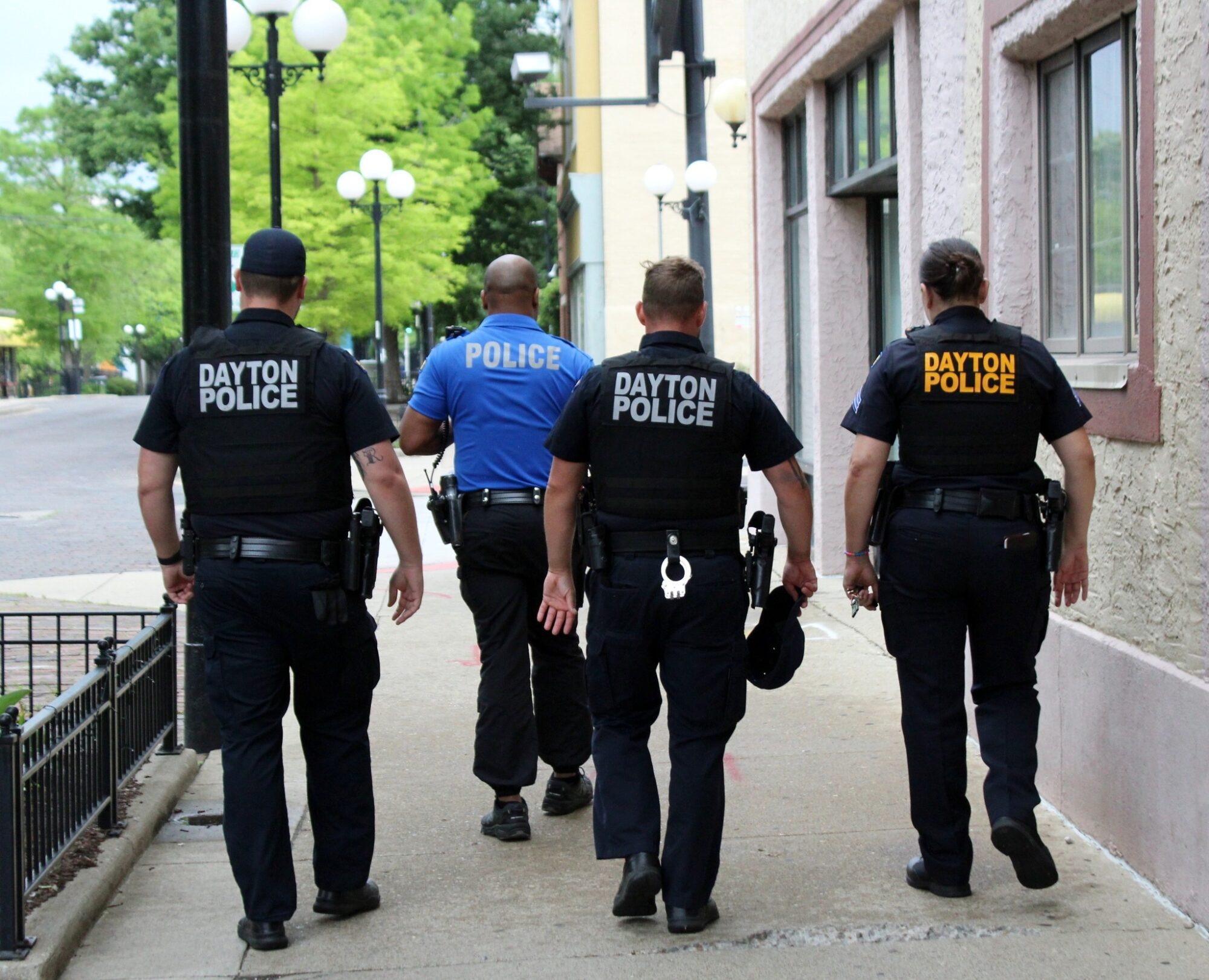Why Dayton Quit ShotSpotter, a Surveillance Tool Many Cities Still Embrace
Police across the country face increased pressure to drop the controversial technology as researchers and activists question its effectiveness.
| July 13, 2023

Julio Mateo and other activists in Dayton, Ohio, tried for years to get police to ditch one of the most controversial trends in law enforcement surveillance technology.
In 2019, the Dayton City Commission approved an initial $205,000 contract with ShotSpotter, a California-based company, to deploy microphones that listen for gunshots across a three-square-mile area of west Dayton, the heart of the city’s Black community, which has a long history of economic segregation and redlining. When the contract came up for an extension in late 2020, Mateo and other Dayton activists circulated a petition that gathered hundreds of signatures demanding the city drop the technology. But the commission approved the extension, nearly tripling the city’s overall spending on ShotSpotter.
So Mateo was a little incredulous, if not pleasantly surprised, when the Dayton Police Department (DPD) announced late last year that it would not seek to extend the ShotSpotter contract beyond December 2022, when it was set to run out. While DPD defended the system, saying it had helped locate shooting victims and get illegal guns off the streets, the police statement announcing the end of ShotSpotter in Dayton partly echoed a broader point that activists had long raised—with police admitting it was “challenging” to prove the effectiveness of the technology.
“It definitely felt like a relief,” says Mateo. “And it definitely felt like our efforts played a role in them making this decision.”
The end of ShotSpotter in Dayton marked a rare victory for activists who have fought against the company’s rapid expansion in Ohio and across the rest of the country in recent years, drawing the attention of groups elsewhere who have been fighting for cities to drop the surveillance technology. Rebranded in April as SoundThinking, the company has rolled out microphones in over 150 cities, feeding sound to proprietary software that the company says identifies gunshots and alerts staffers, who in turn notify local cops. The company, founded in 1996, is now worth around $260 million and has been championed by mayors and police departments across the country, who call it an essential crime-fighting tool and advocate for its lucrative contracts.
SoundThinking claims its system is nearly flawless, but researchers and defense lawyers have challenged its effectiveness as well as the increasing use of the company’s technology as evidence in court. An Associated Press investigation last year found that the company’s microphones can miss gunfire that happens right under them, misclassify fireworks or sounds from cars as gunshots, and that company employees can, and often do, alter evidence gathered by the technology; during a 2016 police shooting trial in Rochester, New York, a ShotSpotter employee admitted to reclassifying sound from a helicopter to a bullet at the request of police.
The largest peer-reviewed study of the technology, a 2021 examination of ShotSpotter across dozens of large metropolitan counties over several years published in the Journal of Urban Health, found that it didn’t significantly reduce gun deaths or increase public safety. Other outside research has concluded the technology largely results in dead-ends for police, including a 2021 analysis of nearly two years of ShotSpotter data in Chicago by the MacArthur Justice Center at Northwestern University’s law school, which determined the vast majority of alerts generated by the company’s gunfire-detection system actually turned up no evidence of gunshots or any gun-related crime.
Last year, the Center sued the City of Chicago seeking to bar the technology’s use in the nation’s third-largest city, filing the lawsuit on behalf of two men falsely accused and jailed in part because of faulty ShotSpotter alerts.
“Every one of these deployments creates a dangerous, high-intensity situation where police are primed by ShotSpotter to expect to find a person who is armed and has just fired a weapon,” the MacArthur Justice Center researchers wrote in one court brief. “Residents who happen to be in the vicinity of a false alert will be regarded as presumptive threats, likely to be targeted by police for investigatory stops, foot pursuits, or worse. These deployments create an extremely dangerous situation for residents, prompting unnecessary and hostile police encounters, and creating the conditions for abusive police tactics that have plagued Chicago for decades.”
A recent Houston Chronicle investigation of ShotSpotter’s deployment in Houston concluded that it mostly resulted in dead-ends for police there, as well as delaying response times for other calls. Another analysis in Dayton by local radio station WYSO had similar findings, showing that fewer than 2 percent of ShotSpotter-initiated police deployments in the city ended with arrests, with just 5 percent of ShotSpotter calls resulted in police reporting incidents of crime—any crime, not just gun crimes.
Jacob Wourms, a Dayton resident and researcher with the police reform group Campaign Zero, told Bolts that ShotSpotter ratcheted up potentially dangerous police encounters in a predominantly Black area of the city. He recalled being on a police ride-along in west Dayton last summer when ShotSpotter alerts for gunshots began to ping on the officer’s phone. “We get to the location, and it was two little boys shooting off fireworks with their grandparents,” Wourms said. He was bothered by the seemingly needless encounter between the children, who were Black, and police, since such interactions can be detrimental.
Some Dayton residents living in the area where ShotSpotter microphones were deployed reported being harassed by police who were responding to a report of shots fired and feel the technology fueled racial profiling.
“[T]hey just start harassing him on the porch,” west Dayton resident Graham Moor told WYSO of his brother’s interaction with police in 2021. “I was fortunate enough that they left.”
People living near ShotSpotter sensors might not even know it. The company doesn’t disclose where it places microphones to police or the public, although they can sometimes be easily spotted on street lamps. Morgan Hood, who lives in the area of west Dayton where the sensors were deployed, told Bolts she wasn’t aware of them. Hood also says she hasn’t noticed any difference in the frequency of gunshots she hears in her neighborhood now compared to a year ago, when ShotSpotter’s sensors were active. “I hear gunshots almost nightly,” she said. “It’s probably people shooting up in the air,” she says.
Dayton police didn’t answer detailed questions sent for this story. But a DPD representative told Bolts the department was never aware of the locations of ShotSpotter sensors nor whether they were even removed from Dayton’s streets, saying that removing them is SoundThinking’s responsibility. Sometimes, the company’s sensors have been left in place even after a contract has expired. Wourms suspects they get left behind in the event that a contract is picked back up again in the future.
SoundThinking also didn’t answer questions sent for this story, including whether its sensors remain in west Dayton. “While we cannot comment on contractual matters, we continue to partner with more and more agencies across the country and stand ready to re-engage with the City of Dayton should the city decide to revisit the use of gunshot detection technology to better serve the citizens of Dayton,” the company said in a statement.
Dayton isn’t the only city that has recently turned away from the company. In November, Atlanta declined to renew its contract with SoundThinking after a six month free trial, while Seattle’s city council chose to exclude funding for the technology in its 2023 budget, despite a push by the city’s mayor to include it. Shares in the company have fallen by nearly half since March.
Even with those setbacks, ShotSpotter surveillance continues to expand in Ohio and across the country. Cincinnati, which adopted it in 2018, recently shelled out millions more to keep it through 2025. Both Cleveland and Columbus expanded the company’s footprint this year. SoundThinking, which has pushed jurisdictions to use federal grant funding to buy its products, claims that six cities deployed its technology in the first three months of the year, resulting in over $8 million worth of new or renewed and expanded contracts.
The company continues to rake in profits even in cities where officials have called for dropping its surveillance technology. While Chicago’s new mayor, Brandon Johnson, vowed to end the city’s contract with SoundThinking during his campaign, he angered many activists last month when his signature appeared on a $10 million payment extending the company’s deal (Johnson’s staff claimed he didn’t know his e-signature was being used for the payment).
Mateo says activists fighting SoundThinking’s rollout or expansion in Detroit, Chicago and California have contacted him in recent months. “Some people (who want to remove ShotSpotter) in Chicago reached out to me to ask if I could potentially come and talk to their group about the Dayton situation,” he says.
Mateo recalled how he and other Dayton activists had scrambled to mount a unified opposition to the contract the first time it was up for renewal in November 2020, during the throes of the COVID-19 pandemic. After the city set the vote for the contract extension for the day before Thanksgiving, activists quickly gathered around 370 signatures for a petition urging the commission to reject it. But pandemic precautions meant the meeting took place over Zoom, without public comments, with commissioners eventually voting four-to-one to extend the contract.
But in the years since, as word got out of the potentially negative consequences of having a private company involved in surveilling communities, a groundswell of opposition rose up.
“I think [city authorities and law enforcement] knew there would be a lot of public pressure this time around [when the contract renewal conversation emerged last fall]. The community had already shown there was opposition to it and we knew that this time it would make its way to the city commission,” says Mateo. “That was not the case the first time around [in 2019].”
The DPD statement announcing the end of the ShotSpotter contract also noted a new law that came into effect in June 2022 legalizing the permitless carry of concealed guns as another reason for discontinuing it; the law makes it more difficult for police to confiscate guns. ShotSpotter’s efficacy was also complicated by the fact that Ohio law does not make it illegal for people to discharge many types of firearms on their own property as long as doing so causes no harm or interference to others.
For opponents of police surveillance technology in Dayton, the battle isn’t over. Last July, three months before announcing the end of ShotSpotter in the city, the city commission approved a contract with the new and rapidly growing surveillance company Flock Safety to install more than three dozen cameras to scan license plates across the city.
Mateo also isn’t convinced that the city is done with ShotSpotter or similar such technology. He fears companies may start combining camera, microphone and facial recognition technologies to sell to law enforcement.
“I don’t think gunshot detection technology is done,” says Mateo. “My concern is that it may come back in a different form, [possibly] as a broader surveillance package.”
Sign up and stay up-to-date
Support us
Bolts is a non-profit newsroom that relies on donations, and it takes resources to produce this work. If you appreciate our value, become a monthly donor or make a contribution.

